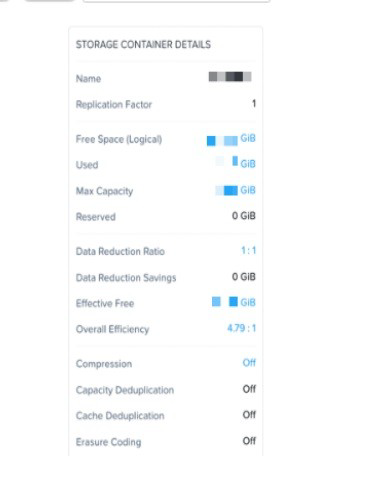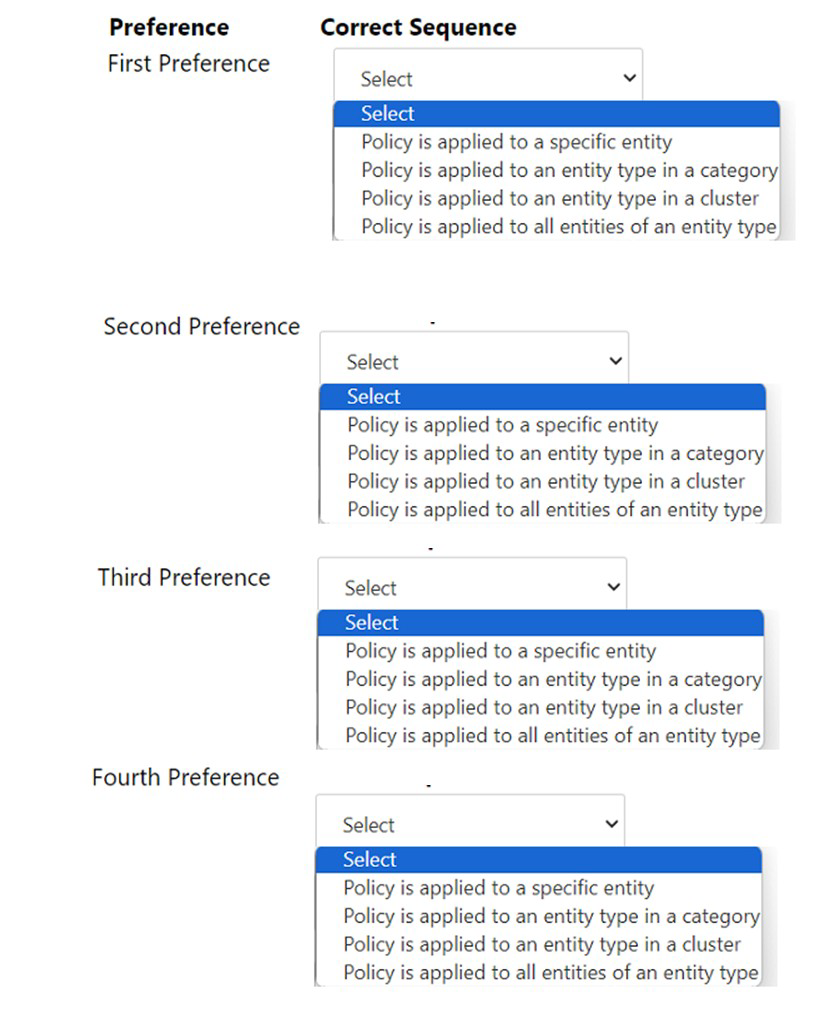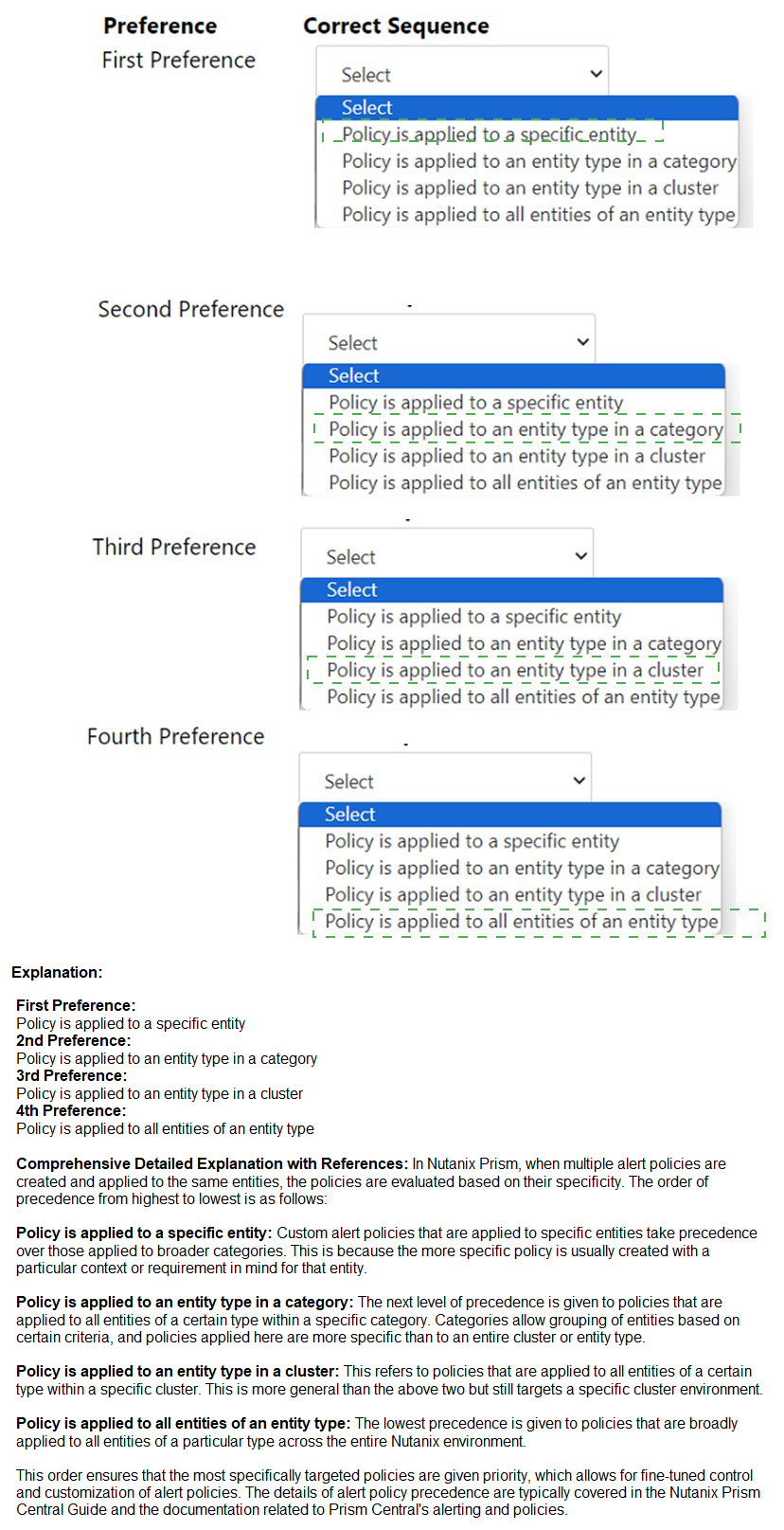| Page 8 out of 30 Pages |
Refer to Exhibit:
An administrator needs to enable inline deduplication for a pre-existing storage container.
When trying to enable deduplication on the storage container. this feature is grayed-out.
What is the reason for this behavior?
A. Replication Factor 1 is configured on the storage container.
B. The cluster has less than 5 nodes which is the minimum node-count to enable deduplication.
C. Capacity reservation is not enabled on the storage container.
D. The cluster has hybrid storage and deduplication is supported only on all-flash clusters.
Explanation: Nutanix supports two types of deduplication: post-process and inline. Postprocess
deduplication runs periodically on a schedule and can be enabled on any cluster.
Inline deduplication runs in real time before data is written to disk and can be enabled only
on all-flash clusters.
Therefore, by checking the type of storage and the type of deduplication, you can
determine if you can enable inline deduplication on a storage container or not.
Nutanix inline deduplication is a feature that reduces the stored size and avoids duplicate
data on a storage container1. It is recommended only on some specific scenarios, such as
when using Nutanix Files or virtual desktop infrastructure (VDI) workloads12.
In which two scenarios is Native Key Management Server supported? (Choose two)
A. XenServer and AHV mixed cluster.
B. Hyper-V and AHV mixed cluster.
C. KVM and AHV mixed cluster.
D. ESXi and AHV mixed cluster
An administrator is reviewing performance of a core banking system that routinely has
20,000 concurrent users. During, business hours, the CPU on the applications servers runs
at close to 100%. The administrator needs to determine if there is a performance issue
specific to the app servers, the database servers, or all servers on the cluster.
Which metrics should the administrator review in Prism Analysis Graphs?
A. Cluster IO, Network, Database and App Server CPU
B. Cluster CPU and Memory Only
C. Cluster IO, CPU, Memory and Database and App Server CPU
D. Cluster IO, CPU, Memory, Network, App Server CPU
Explanation: In this case, the administrator wants to investigate the performance of a core
banking system that consists of application servers and database servers. The application
servers have high CPU utilization during business hours, which may indicate a bottleneck
or a resource contention issue. The administrator needs to review multiple metrics in Prism
Analysis Graphs to identify the root cause and determine if there is a problem with the app
servers only, or with other components as well.
The metrics that are relevant for this analysis are:
Cluster IO: This metric shows the input/output operations per second (IOPS) and
throughput (MBps) of the cluster. It can help to understand if there is a high
demand for disk IO from the VMs or if there is any latency or congestion in the
storage layer.
Cluster CPU: This metric shows the CPU utilization (%) and load average of the
cluster. It can help to understand if there is enough CPU capacity in the cluster to
handle the workload or if there is any imbalance or contention among hosts.
Cluster Memory: This metric shows the memory utilization (%) and available
memory (GB) of the cluster. It can help to understand if there is enough memory
capacity in the cluster to support the VMs or if there is any pressure or swapping in
the memory layer.
Network: This metric shows the network throughput (MBps) and packets per
second (pps) of the cluster. It can help to understand if there is enough network
bandwidth in the cluster to transfer data between hosts and VMs or if there is any
congestion or packet loss in the network layer.
App Server CPU: This metric shows the CPU utilization (%) and load average of
each application server VM. It can help to understand if there is any variation or
anomaly in the performance of each app server or if there is any correlation with
other metrics.
Database Server CPU: This metric shows the CPU utilization (%) and load
average of each database server VM. It can help to understand if there is any
variation or anomaly in the performance of each database server or if there is any
correlation with other metrics.
An administrator is commissioning a Nutanix Enterprise Cloud. Once the user VMs have been deployed and are running, the administrator finds that VMs on the same host are able to communicate, but are unable to communicate between hosts. What must be changed to enable full inter-VM communications?
A. Change the spanning-tree port type on the switch.
B. Change the network the VMs are connected to
C. Update the switch to specifically allow VLAN 15
D. The VMs need to have static IP addresses.
Explanation: According to the web search results, one possible cause of inter-VM communication failure between hosts is that the switch is not configured to allow VLAN 15 traffic. VLAN 15 is the default VLAN ID used by AHV for internal communication between CVMs and hosts. If the switch blocks or drops VLAN 15 packets, it will prevent inter-VM communication across hosts4. To enable full inter-VM communication, the administrator should update the switch to specifically allow VLAN 15 traffic on the ports connected to the AHV hosts.
An administrator has created several custom alert policies, which are applied to the same entities. Prism Central displays a message that a similar policy exists. In what order of precedence are overlapping policies evaluated?


An administrator has created a Nutanix managed it a VLAN ID of 512.
Several VMs have been created, and the administrator notices that the can successfully
communicate with other VMs on that VLAN.
Provided they are on the host, but cannot communicate with VMs that reside on different
hosts in the cluster.
What is most likely thee cause of this issue?
A. There is a firewall rule blockingVLAN512 traffic.
B. VLANS12 is a reserved VLAN ID, and not usable for guest VMs.
C. The VLAN was not created on the upstream switches.
D. The administrator did not create the VLAN on all hosts
Explanation:
The correct answer is C. The VLAN was not created on the upstream switches.
A VLAN (virtual local area network) is a logical segmentation of a physical network that
allows devices on the same VLAN to communicate with each other, regardless of their
physical location. A VLAN also isolates the devices on different VLANs from each other,
unless there is a router or a layer 3 switch that can route traffic between VLANs. To create
a VLAN, the administrator needs to configure the network devices that are involved in the
VLAN, such as switches, routers, and hosts. The administrator also needs to assign a
unique VLAN ID to each VLAN, which is a number between 1 and 4094 that identifies the
VLAN1.
In Nutanix AHV, the administrator can create a Nutanix managed network with a specific
VLAN ID for guest VMs. This network can be assigned to VM NICs using Prism Element or
Prism Central. However, creating a Nutanix managed network does not automatically
create the VLAN on the upstream switches that connect the AHV hosts. The administrator
needs to manually configure the upstream switches to allow the VLAN traffic on the ports
that connect to the AHV hosts. The administrator also needs to ensure that the upstream
switches are interconnected physically or virtually and can forward traffic between different
VLANs if needed2.
Therefore, if an administrator has created a Nutanix managed network with a VLAN ID of
512 and notices that the VMs on that network can only communicate with other VMs on the
same host, but not with VMs on different hosts in the cluster, the most likely cause of this
issue is that the VLAN was not created on the upstream switches. This means that the
switches are dropping or blocking the traffic with VLAN ID 512 and preventing it from
reaching other hosts or VMs. To resolve this issue, the administrator should create the
VLAN on the upstream switches and allow it on the ports that connect to the AHV hosts3.
| Page 8 out of 30 Pages |
| Nutanix NCP-MCI-6.5 Practice Questions Home | Previous |